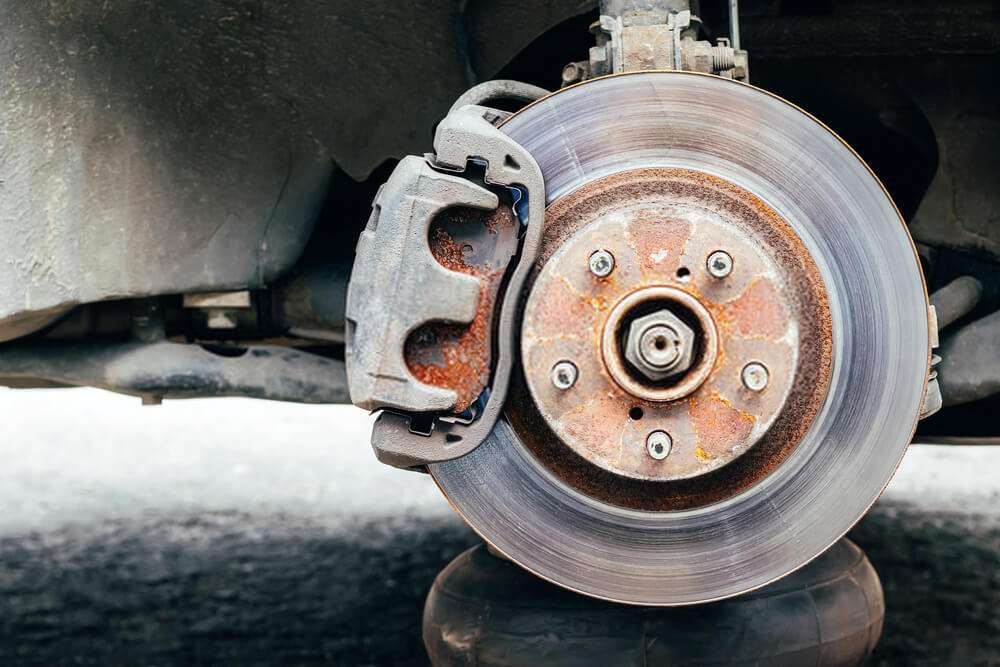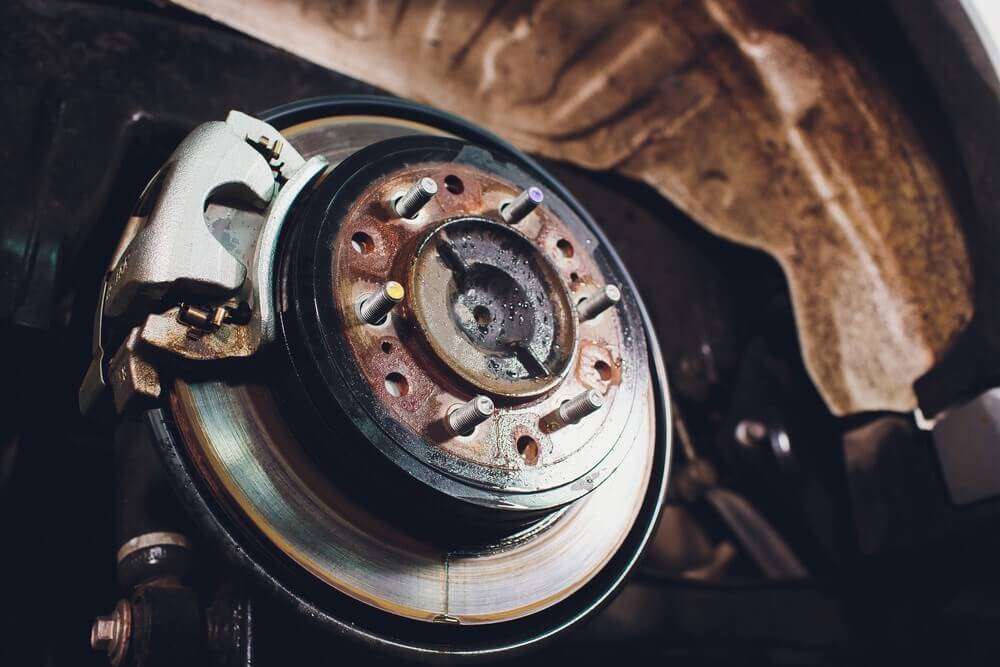There’s nothing more frustrating than a rusty brake rotor. Not only does it make your car look ugly, but the rust also tends to build up and hinder the effectiveness of your brakes, bringing you closer to an accident. Luckily, with just a few simple steps and tools, you can remove rust from brake rotors in no time at all. In this article, we’ll go over how to do that.
Rust is a common foe in the automotive world. It can be especially detrimental to brake rotors, which see a lot of friction and action in their lifetime. If your rotors are starting to show signs of rust, you’ll need to take care of it right away if you want them to last.
Jump to
- 1 How to Remove Rust from Brake Rotors – Quick Method!
- 2 Removing Rust with a Wire Brush and Sand Paper:
- 2.1 Causes of Rust in Brake Rotors
- 2.2 FAQs
- 2.2.1 Q. Can you get rust under your paint?
- 2.2.2 Q. How can I prevent brake rotor corrosion in the future?
- 2.2.3 Q. What kind of things cause brake rotors to rust?
- 2.2.4 Q. How can you know that Rotors are starting to rust?
- 2.2.5 Q. Can I use paint thinner for cleaning the rusty parts of my brakes’ rotors?
How to Remove Rust from Brake Rotors – Quick Method!
Have you got just a little bit of rust and don’t want to wait any longer? Here is the fastest way to remove corrosion from your car rotors.
Tools You Will Need to Do this Job:
You can need a variety of tools and supplies for this job, such as:
- A rubber mallet
- A wire brush (fine and medium) and
- Sandpaper
- Metal Polish
Removing Rust with a Wire Brush and Sand Paper:
let’s get started!
Step 1: Jack up the Car
Jack up the car securely and place safe supporting stands underneath it.
Step 2: Loosen Lug Nuts on Wheel
One of the first things you’ll need to do before you start working is to loosen up your wheel lugs and remove your wheels. Be sure to use the proper size wrench and not overdo it, or you’ll risk stripping your lug nuts.
Step 3: Remove Rotor from Car
Once you’ve removed your wheels, use the mallet to carefully pound out the rotor. If there is a lot of rust build-up, you may have to do this several times. Be careful not to use too much force with the mallet, as that can crack your rotor.
Step 4: Clean the Surface of Your Rotors
Once you’ve hammered it out of the way, use the wire brush to remove any rust or debris from it. Use both a fine and medium wire brush to get the job done as effectively as possible. Be sure to use heavy pressure while doing this, but don’t apply too much force. You don’t want to cause the rotor to crack.
Next, use sandpaper (80-grit is recommended) and sand the rotor, making sure to remove any wire brush debris or rust particles that may be leftover. As you work your way around the rotor, keep in mind that you might need to use a wire brush and sandpaper in the opposite direction to scrape off all possible rust. You can also start out using sandpaper with a coarser grit and finish off with a fine one.
Step 5: Treat Your Rotors with Brake Parts Cleaner
After using the wire brush on a section of the rotor, you’ll want to spray it with brake cleaner. This citrus-based solution should help loosen up any rust or corrosion on the rotors. Try to get this on all surface areas, as it will work best if it’s applied directly to the metal.
Step 6: Apply More Brake Parts Cleaner and Let It Sit for Some Time
After you’ve sprayed the brake cleaner on the rotors, cover them with a plastic bag and let them sit for 1-2 hours. This will allow both the cleaning solution and the rust to penetrate the metal so that they can loosen up together.
After this time has elapsed, remove your rotors from the plastic bag. You should be able to see a layer of rust on top of the metal.
Step 7: Use a Medium Wire Brush to Remove the Remaining Rust
After you’ve given your rotors some time to sit with brake cleaner, brush on the medium wire brush to remove all of the loose rust particles and grime. This should leave your rotors looking nice and clean.
Step 8: Sand off any Remaining Rust and Polish
Once you’ve removed all of the rust using a wire brush, you can give your rotors a final polish with some sandpaper. This will ensure that any remaining rust has been completely removed. You can then apply some metal polish for a nice shine.
Your rotors should now look good as new!
You can repeat these steps to clean your rotors up if you notice any rust reappearing after a few weeks or months.
Causes of Rust in Brake Rotors

Below are some of the most common causes of rust in Brake Rotors.
- One of the primary causes is moisture and debris that gets stuck on the brake pads. Brake dust and moisture then get trapped in between the rotor and wheel cylinder, causing corrosion to build up.
- Another common cause is road salt. It’s very common for road salt to get stuck in between brake pads and rotor and cause corrosion.
- If you live in an area that has a lot of heavy rain or snow, then rust can build up between the rotor and wheel cylinder.
- Also, scratches on the surface of your rotors can cause rust to build up.
- If your brake rotor has been getting a lot of heavy use, then that too can cause rust to build up.
- When a vehicle is unused for a long period, rust will develop naturally.
Conclusion!
It may seem like a lot of work to remove rust from your brake rotors, but the results are worth it. Knowing how to clean your brake rotors can save you a lot of money by preventing the need to replace them.
Be sure to only use products that are safe for use on brake rotors. A lot of commercial cleaning products contain acids that can damage the metal.
If you don’t have any brake cleaner on hand, then a mixture of vinegar and water will also work – just make sure to use it sparingly.
We’d love to hear from you! If you’ve found this article helpful for your vehicle, please feel free to share this information with other drivers.
If you have any questions, please leave a comment below or head over to our contact us page and we’ll get back to you.
FAQs
Q. Can you get rust under your paint?
Paint is a protective layer that helps guard against rust, though it isn’t impenetrable. It’s possible that moisture can still find its way under your paint and cause rust.
Tiny holes will need to be fixed with touch up, but larger problems can often be solved more easily by getting a new paint job.
Q. How can I prevent brake rotor corrosion in the future?
The best way to prevent rust in your brake rotors is by using quality parts and proper care.
It’s important to use genuine brake parts. Don’t be tempted by cheap knockoffs that will wear out faster or fail sooner.
Clean your brake rotors regularly with brake cleaner, and apply a coat of rust inhibitor to the rotor whenever you change your brake pads. This will help protect it from water and salt.
If your car has been sitting unused for a long period, then it’s best to give your brake rotors a quick cleaning before driving again.
If you’re concerned about corrosion, then consider switching to a ceramic brake pad set. These are made of an abrasive ceramic material that doesn’t attract rust or corrosion.
Q. What kind of things cause brake rotors to rust?
Brake rotors can rust when moisture seeps into the metal through tiny scratches or imperfections on the surface. Moreover, dust and salt from the road can stick to brake pads and cause rust.
Q. How can you know that Rotors are starting to rust?
Rotor discoloration is a telltale sign of rust development that you may notice while driving or in your garage. The discoloration is the same color as rust, so it’s easy to see.
The rotor surface will also become rough if there is rust in the disc. This is because rust will make it hard for brake pads to make clean contact with the rotor surface, causing them to wear down unevenly.
Another sign that your rotors have rust is if you hear the “squeal” or grinding sound when accelerating, braking, or turning.
Q. Can I use paint thinner for cleaning the rusty parts of my brakes’ rotors?
Paint thinner contains chemicals that are not safe for use on brake rotors. When you apply a harsh chemical to your brakes’ rotors, rust particles can be dislodged and pushed deeper into the metal.
Also Read: What is the Average Lifetime of Brake Rotors

My name is Tom Harris, founder of this blog. I’m a mechanical engineer with 20 years of experience in the automotive industry. I’m here to help you with your vehicle’s problems, easy fixes and share my insights and experience so that you can enjoy your rides more.

